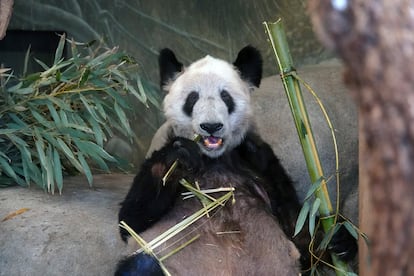The return of a panda bear highlights battered relations between US and China
The state of health of an animal named Ya Ya had become the focus of a heated debate that triggered displays of nationalism on Chinese social media

The return of the giant panda Ya Ya to China has become the latest symbol of the fragile relations between the two major world powers. Ya Ya arrived in Shanghai on Thursday afternoon after leaving the Memphis Zoo (Tennessee), where she had lived for the past two decades with her partner Le Le, who died in February.
The animal’s departure marks the end of a 20-year loan deal and coincides with a period in which mistrust between Beijing and Washington is at an all-time high. Rumors and accusations of animal abuse had intensified in recent months, at a time when each gesture is analyzed down to the last detail by both sides. Ya Ya has been received in China as a star; the state media have provided extensive coverage of the event and the internet is abuzz with messages of welcome and celebration.
Since the death of Le Le on February 1 —two days before the Pentagon detected a Chinese balloon over US soil that it accused of espionage—, Chinese social media had been rife with debate about the treatment the pandas were receiving in Memphis. Videos showing Ya Ya looking very skinny and with bald spots in her faded fur went viral while a completely different image came from Russia: the chubby Ru Yi and Ding Ding, the pandas that live in the Moscow zoo, were featured in the Chinese media doing somersaults and eating happily in the Moscow facility. “It’s the clear difference between how a good and an evil stepmother treats you,” wrote a user of the social network Weibo. In April, the panda Lin Hui died in Thailand, a death that went virtually unnoticed in Chinese forums.
In 2021, the US group In Defense of Animals accused the Memphis Zoo of failing to properly care for the panda couple, alleging that they were suffering from “physical, mental and emotional deprivation.” Zoo managers have always denied these claims and said that Ya Ya suffers from a chronic skin and coat problem inherent to her immune system and affected by hormonal changes. Zoo director Matt Thompson went so far as to say that Le Le and Ya Ya were “two of the most pampered animals on the planet.”
Despite the fact that these rumors were also silenced by the Chinese authorities, comments still abound on Weibo criticizing the “suffering” that this “national treasure” has suffered “far from the beloved homeland.” On Wednesday, the Ministry of Foreign Affairs assured that “the pandas have been properly cared for and were very loved by the Americans.”
“The giant panda has played a pivotal role as a symbol of friendly exchanges between China and the United States. These cute giant pandas, unique in China, have a special mission,” reads an editorial published Thursday in the government-run Global Times newspaper. Soon after, its controversial former director, Hu Xijing, speculated on his personal blog that with the return of Ya Ya, “the curtain is lowered on what China-US relations were 20 years ago.”
“The worst is the US political elite, which has broken the friendship and basic trust and has generated a spiral of mutual suspicion, causing both peoples to question everything,” Hu lashed out.
How China has changed in 20 years
Ya Ya (Beijing, 2000) and Le Le (Shanghai, 1998-2023) arrived in Memphis in 2003 as part of a conservation and research project between the Chinese Association of Zoos and the United States. The context in which that loan occurred was very different from the current one. China had entered the World Trade Organization (WTO) just two years earlier with the approval of the United States, which hoped that, as that emerging giant developed, it would end up becoming a liberal democracy with a market economy similar to those of the West. China’s entry into the WTO changed the multilateral trade system and led hundreds of foreign companies to set up shop on its territory.
Much has happened since then, from US criticism of alleged abuses by the Chinese government against ethnic minorities in Tibet and Xinjiang, to the repression following pro-democracy protests in Hong Kong, to the trade war. And suspicion reaches a climax when it comes to Taiwan, the democratically self-governing island that Washington supplies with weapons but which China considers an inalienable part of its territory. Meanwhile, mistrust continues regarding the neutrality that Beijing claims to maintain in the war in Ukraine. Xi Jinping, who has not condemned the invasion, spoke last Wednesday with Ukrainian President Volodymyr Zelenskiy for the first time since the start of the war. In the year and two months of war, however, the Chinese leader has not hidden the good harmony he maintains with his “dear friend” Vladimir Putin.
Panda diplomacy
What is known as panda diplomacy began before the establishment of the People’s Republic, which occurred in 1949. Eight years earlier, in 1941, the then Republic of China gave the United States a pair of these bears in gratitude for their help during the Japanese invasion. These precious gifts were limited to allied countries once the Communist Party took power, but since the 1970s, when Beijing began to connect with the world, the black and white animals have become goodwill ambassadors destined for to strengthen relations with the West. The United States received a pair of pandas after the historic meeting between Richard Nixon and Mao Zedong in the Chinese capital in 1972, which started the thaw between Washington and Beijing.
The pandas are considered a kind of “award” with which China shows its friendship to those nations with which it has a good bilateral relationship. However, since 1984, it has only rented them out and for large sums of money. The contracts are usually for around 10 years and are estimated to be around a million dollars. To this amount must be added the high cost of maintaining very delicate animals, which feed mainly on fresh bamboo shoots. According to data from the World Wide Fund for Nature (WWF), there are 1,864 pandas in the wild and 50 in captivity in 26 zoos in 21 countries.
Sign up for our weekly newsletter to get more English-language news coverage from EL PAÍS USA Edition
Tu suscripción se está usando en otro dispositivo
¿Quieres añadir otro usuario a tu suscripción?
Si continúas leyendo en este dispositivo, no se podrá leer en el otro.
FlechaTu suscripción se está usando en otro dispositivo y solo puedes acceder a EL PAÍS desde un dispositivo a la vez.
Si quieres compartir tu cuenta, cambia tu suscripción a la modalidad Premium, así podrás añadir otro usuario. Cada uno accederá con su propia cuenta de email, lo que os permitirá personalizar vuestra experiencia en EL PAÍS.
¿Tienes una suscripción de empresa? Accede aquí para contratar más cuentas.
En el caso de no saber quién está usando tu cuenta, te recomendamos cambiar tu contraseña aquí.
Si decides continuar compartiendo tu cuenta, este mensaje se mostrará en tu dispositivo y en el de la otra persona que está usando tu cuenta de forma indefinida, afectando a tu experiencia de lectura. Puedes consultar aquí los términos y condiciones de la suscripción digital.
More information
Archived In
Últimas noticias
From digital curfews to blocking apps: How technology experts protect their children online
Why the price of coffee has skyrocketed: from Brazilian plantations to specialty coffee houses
Confined to a Cuban hospital: When electricity is a matter of life or death
Half of Scotland is in the hands of 420 property owners
Most viewed
- Pablo Escobar’s hippos: A serious environmental problem, 40 years on
- Reinhard Genzel, Nobel laureate in physics: ‘One-minute videos will never give you the truth’
- Why we lost the habit of sleeping in two segments and how that changed our sense of time
- Charles Dubouloz, mountaineering star, retires at 36 with a farewell tour inspired by Walter Bonatti
- The Florida Keys tourist paradise is besieged by immigration agents: ‘We’ve never seen anything like this’











































